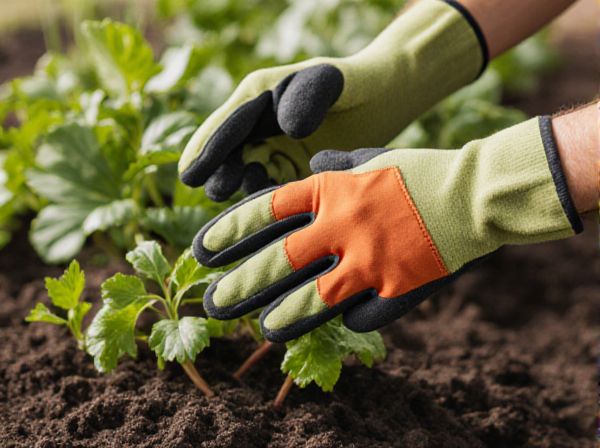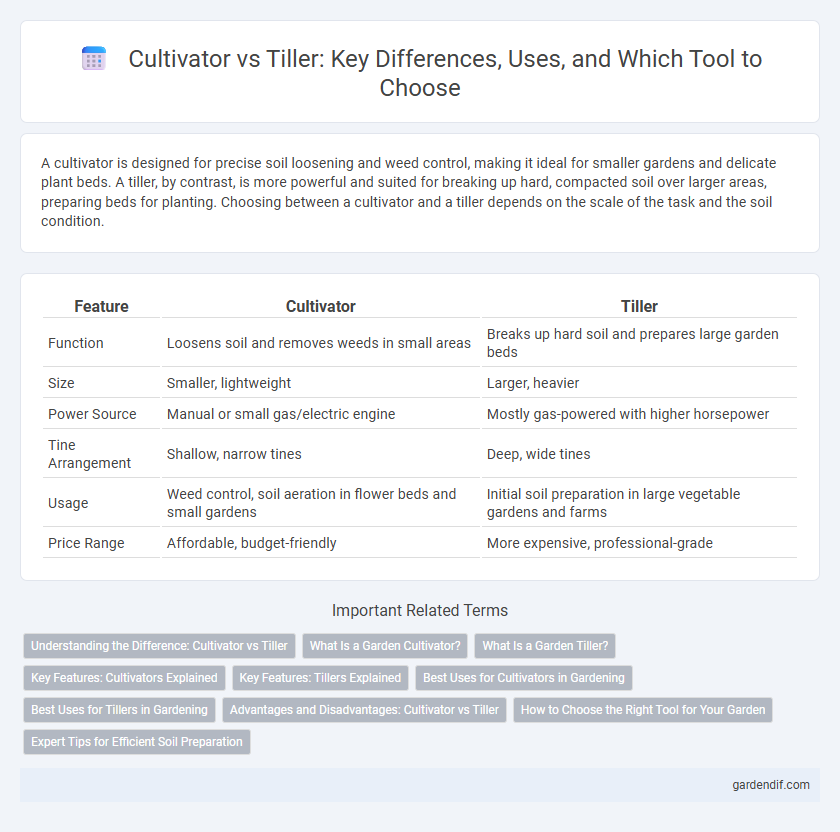
Cultivator vs tiller Illustration
A cultivator is designed for precise soil loosening and weed control, making it ideal for smaller gardens and delicate plant beds. A tiller, by contrast, is more powerful and suited for breaking up hard, compacted soil over larger areas, preparing beds for planting. Choosing between a cultivator and a tiller depends on the scale of the task and the soil condition.
Table of Comparison
| Feature | Cultivator | Tiller |
|---|---|---|
| Function | Loosens soil and removes weeds in small areas | Breaks up hard soil and prepares large garden beds |
| Size | Smaller, lightweight | Larger, heavier |
| Power Source | Manual or small gas/electric engine | Mostly gas-powered with higher horsepower |
| Tine Arrangement | Shallow, narrow tines | Deep, wide tines |
| Usage | Weed control, soil aeration in flower beds and small gardens | Initial soil preparation in large vegetable gardens and farms |
| Price Range | Affordable, budget-friendly | More expensive, professional-grade |
Understanding the Difference: Cultivator vs Tiller
Cultivators and tillers serve distinct roles in soil preparation, with cultivators primarily designed for aerating soil and removing weeds around existing plants, while tillers are used to break up and turn over large areas of unworked soil. Cultivators typically feature narrower tines for gentle soil disturbance, whereas tillers have wider, stronger tines to penetrate and mix compacted soil deeper. Understanding the difference between a cultivator and a tiller is essential for selecting the right tool to optimize soil health and improve garden productivity.
What Is a Garden Cultivator?
A garden cultivator is a power tool designed to loosen soil, control weeds, and aerate the ground in smaller garden beds. Unlike a tiller, which turns and breaks up hard, compacted soil on a larger scale, cultivators focus on light soil preparation and maintenance tasks. They typically feature rotating tines that work the soil without deeply disturbing the root zones of plants.
What Is a Garden Tiller?
A garden tiller is a powerful gardening tool designed to break up and aerate soil, making it easier to plant and encouraging healthy root growth. Unlike cultivators, which are primarily used for light weeding and shallow soil mixing, tillers penetrate deeper to turn over larger areas of tough, compacted earth. This tool is essential for preparing garden beds and improving soil structure before planting.
Key Features: Cultivators Explained
Cultivators are designed primarily for soil aeration and weed control with narrow tines that penetrate shallowly, preserving plant roots and encouraging healthy growth. They typically feature adjustable tine depth and width, allowing precise cultivation in garden beds and between rows of crops. Unlike tillers, cultivators are lighter and more maneuverable, making them ideal for delicate tasks and maintenance work in smaller or established garden areas.
Key Features: Tillers Explained
Tillers are powerful gardening tools designed to break up compact soil using rotating blades or tines that dig deep, promoting aeration and facilitating root growth. They often come with adjustable tine speeds and depths, allowing precise control for preparing seedbeds or mixing in compost efficiently. Compared to cultivators, tillers excel in handling tougher ground conditions and larger garden areas, making them essential for initial soil preparation.
Best Uses for Cultivators in Gardening
Cultivators are best used in gardening for aerating soil, removing weeds, and mixing soil amendments in small to medium-sized garden beds. They provide precise control around delicate plants, making them ideal for maintaining flower beds, vegetable gardens, and raised beds without damaging roots. Cultivators are also effective in loosening soil surface and promoting healthy root growth, enhancing overall plant health.
Best Uses for Tillers in Gardening
Tillers are ideal for breaking up compacted soil and preparing large garden beds quickly, making them perfect for initial soil cultivation and mixing in organic matter. They excel in creating a fine seedbed by pulverizing the soil, which enhances root penetration and water absorption for optimal plant growth. Tilling is especially beneficial for incorporating compost, fertilizers, or amendments evenly throughout the garden soil before planting.
Advantages and Disadvantages: Cultivator vs Tiller
A cultivator offers precise soil aeration and weed control with minimal soil disturbance, making it ideal for garden beds and smaller plots, but it struggles with hard or compacted soil. Tillers excel in breaking up tough ground and preparing large areas quickly, though they can overly disrupt soil structure and increase erosion risks. Choosing between a cultivator and tiller depends on soil condition, plot size, and the desired level of soil turnover.
How to Choose the Right Tool for Your Garden
Choosing between a cultivator and a tiller depends on the size and condition of your garden soil; tillers are ideal for breaking new ground or handling heavy, compacted earth, while cultivators work best for aerating and mixing soil in established beds. Consider factors such as soil type, garden scale, and desired depth of cultivation, since tillers offer deeper, more aggressive turning, whereas cultivators provide lighter, more precise soil preparation. Selecting the right tool optimizes soil health and plant growth, improving overall garden productivity.
Expert Tips for Efficient Soil Preparation
Cultivators excel at aerating soil and controlling weeds by agitating the top layer without disturbing deeper roots, making them ideal for maintenance between rows. Tillers are designed for heavy-duty soil breaking, turning over compacted ground to prepare new planting beds effectively. Expert tips recommend using a tiller for initial soil preparation to break ground and a cultivator for ongoing soil aeration to enhance nutrient absorption and root growth.
Cultivator vs tiller Infographic

 gardendif.com
gardendif.com